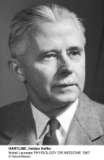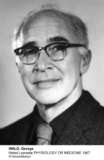


 |
||
|
1967 - Ragnar Granit, Haldan Keffer Hartline, George Wald
Light, shadows and colors do not exist in the world around us. What we perceive visually and call light is the result of the action of certain electromagnetic radiation on sensory cells in the retina. Granit's investigations led him to the conclusion that there are different types of cones representing three characteristic spectral sensitivities. This was confirmed by a few research groups, implying that the signal patterns transmitted to the brain and resulting in the perception of colors depend on contributions from three types of cone cells. Studding the eye of the horseshoe crab, Hartline discovered the phenomenon of lateral inhibition, later obtaining a quantitative description of data processing by means of inhibition in a network of sensory cells. This is the basis of the physiological mechanism whereby heightened contrast sharpens the visual impressions of form and movement. Wald found that the light-sensitive substances in the sensory cells consist two pieces: the chromophore containing vitamin A, and a larger protein called opsin. Light induces isomerization of the chromophore, which triggers the subsequent events in the visual system. This mechanism plays a role in photoreceptors of all living animals.
|
||



